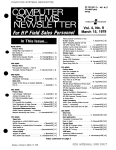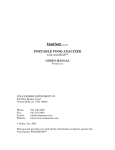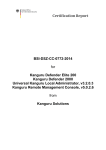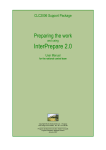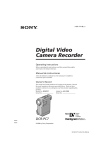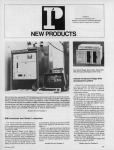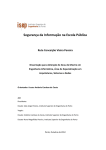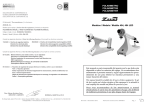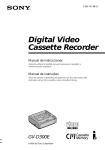Download NEW PRODUCTS
Transcript
edited by Dr. Demetrios A. Michalopoulos Associate Professor of Computer Sciences California State University at Fullerton NEW PRODUCTS HP offers Basic-language desktop computing system The new 26-pound HP 9831A desktop computer can be used as a stand-alone, Basic-language computer or linked with peripherals to form systems, according to its manufacturer, Hewlett-Packard. The HP 9831 comes with 8K bytes of memory, expandable to 32K bytes in 8K byte increments. Basic language commands for String Variables, Input/Output, and Advanced Programming II operations are built in. String Variables programming permits handling of string arrays as large as the total memory of the machine. Optional matrix/plotter flexible disk ROMs, providing such standard matrix operations as inversion, transportation and multiplication, and twodimension array operators, are also available. The desktop computer can work with master and slave flexible-disk drives for additional, fast-access memory; plotters; thermal- and character-impact printers; and CRT terminals. It features a built-in bi-directional tape drive. With 90-ips searchand-rewind speed and a 22-ips read/write speed, the tape cartridge drive gives an average access time of 6 seconds. Most software pacs available for use with the HP 9830 desktop computer are directly compatible with the 9831, and program transmission between the two can be accomplished in seconds, according to the company. The 9831's keyboard has 12 specialfunction keys that, with a shift function, can handle 24 different operations. The keys can accommodate complete programs and can serve as inmmediate-execute keys, call keys for subroutines, and as typing aids. Error locations are identified by a cursor in the display. Fixed- and floatingpoint formats can be set by the user from the keyboard. The 32-character LED display provides upper- and lower-case alphanumeric readout, covering the full ASCII character set. The 9831's tape cartridge has two tracks and can hold 250K bytes with a 2750 byte-per-second transfer rate. Using the cartridge, the operator can perform rapid memory-load and record operations. 80 Hitachi develops M-150 medium-scale M-Series computer The 9831 comes with 8K bytes of internal read/write memory, which is expandable in optional 8K increments to a total of 32K bytes. Four plug-in slots in the front of the computer provide space for optional ROMs. Through as many as three interface cards, the 9831 will work with standard HP peripherals. Initial customer deliveries of the new 9831A desktop computer, priced at $7200, were scheduled to begin in March. A new medium-scale computer, HITAC M-150, has been introduced by Hitachi, Ltd. The M-150 system features highspeed auxiliary storage, large-volume ifies, communications control processors, and virtual storage features. It is one of three medium-to-small-scale computers which Hitachi has in development, and is the seventh computer thus far in the M-Series. Shipment is scheduled to begin in the fall. The M-Series models, comprised of medium- to large-scale systems, utilize conforming architecture and are designed to unify software and input/output interfaces within the series, Hitachi states. The system expands on-line, data base data communication capabilities to comply with the patterns in computer applications which are developing toward demand processing, file processing, and programming in conversational operation with the computer. Reader Service Number 17 Reader Service Number 19 i6i.;_ AM Analog 110 systems provide interface for Pro-Log microcomputers Burr-Brown's newest analog I/O systems are single-board units which are plug compatible with Pro-Log 4 or 8-bit microcomputers. Both the 4216 (16-channel input board) and 4102 (2-channel output board) plug into the Pro-Log card file, wire wrapping the card file bus connector and making connection to analog inputs, outputs, and ± 15V supplies. The boards can be treated as memory by the CPU-each channel requiring one 8-bit memory location. The address block occupied by each board is strap selectable, thus they can be located anywhere in memory. Alternatively, the systems can be treated as I/O. Intended primarily for industrial control or test-equipment applications according to Burr-Brown, each input board is a 16-channel differential-input system. Input flexibility allows the user to select full-scale input ranges between ±10 mV and ± 1OV. Process current-loop input signals such as 4-20 mA and 10-50 mA are also handled by adding series dropping resistors. Analog inputs are converted with 8-bit resolution and with throughput accuracy ranging from ±0.5% of full scale reading on the ±10V range to ±0.7% of full scale reading on the ± 10 mV range. Conversion time is 60 Atsec. Output boards contain two channels each and are jumpered at the factory for ± 1OV operation (two's complement coding). Boards can be altered to provide 0 to + 10V operation (straight binary coding). Output resolution is also 8-bit and throughput accuracy is ±0.4% of full scale reading. Unit prices for the 4216 (16-channel input) and 4102 (2-channel output) are $295 and $195, respectively. In quantities of 100, prices drop to $180 and $120. Delivery is from stock for small quantities. Reader Service Number 18 COM PUTER TI offers new terminals, software development system Texas Instruments recently announced its new Series 700 Model 770 intelligent terminal for data processing and data communications in distributed processing environments. At the same time, TI introduced a video display terminal and floppy-disk-based software development system for users of the 990 mini/microcomputer family, plus a new microcomputer-based pharmacy system. The 770 desktop terminal utilizes ROM and RAM memory, dual minicartridge magnetic tape drives, a 1920-character video display, and a full ASCII keyboard with separate numeric, cursor control, and programmable function key clusters. Operation of the 770 is supported by a real-time, multi-tasking executive which resides in ROM memory. The 770's business-oriented Terminal Programming Language, TPL 700, simplifies the data entry, data processing, and software development functions, TI states. This highlevel language combmies a "fill-in-the-blank" forms package for data entry applications with an English-like procedure language for data processing applications. The Model 770's options include RAM memory expansion up to 24K bytes, an integral Silent 700 30-cps non-impact printer, TI's recently announced 150-cps Model 810 printer, video display graphics, and a set of communications interfaces, modems, and auto call units. The quantity one purchase price for the 770 terminal with 8K bytes of memory is $6400, with quantity discounts and various lease plans available. Production deliveries are scheduled to begin in June. The Model 911 terminal for use with TI's 990 mini/microcomputer family consists of a display unit, a separate keyboard, and a printed-circuit-board controller which mounts in a 990 chassis. It is available in either 960- or 1920character versions for both domestic and European use. The display features an 8.5" x 5.5" monitor with 5 x 7 dot matrix characters. The 960-character version uses 12 lines of 80 characters and the 1920-character version uses 24 lines. The keyboard, a separate unit connected to the display by a five-foot cable, features a full ASCII 128-character set as well as the capability to support 38 special functions. Refresh memory is mounted on the controller in a Model 990/4 or 990/10 computer chassis, and a composite video signal is transmitted via coaxial cable from computer display. The terminal is supported by standard 990 software including the TX990 memoryresident operating system and DX10 disk operating system. The 1920-character version is priced at $1700 for single units and at $1088 for quantities of 50. Deliveries will begin in July. Two new floppy-disk-based software development systems, FS990/4 and FS990/ 10, support software and firmware development for the TMS 9900 microprocessor, the Model 990/4 microcomputer, and the Model 990/10 minicomputer. System software includes the TX990 executive opMay 1977 Among recent introductions from Texas Instruments are the Model 770 intelligent data terminal (above) for distributed processing environments and the FS 990/4 floppy disk software development system (right) for the company's Model 990/4 microcomputer. TI also announced a new video display terminal and a microcomputer system for processing prescription data. erating system and TXDS development utilities. Packaged in single-bay desk enclosure, the FS990/4 system includes the Model 990/4 microcomputer with 24K 16-bit words of memory with parity, dual floppy disks with 484K bytes of storage, and the Model 913 video display terminal. Prices for the system start at $10,500, and at $13,500 for the FS990/10. Both wiU be available this month. In conjunction with a host computer, the new Model 400 pharmacy system edits, prints, and stores prescription data, displays prior drug records, and checks patient eligibility for third-party payments. The system features TI's new 1920- character Model 911 video display terminal, the recently announced Model 810 printer, and a Model 990/4 microcomputer with up to 56K bytes of memory. Unit price of the pharmacy system is $7075, with quantity discounts available under a volume purchase agreement. Delivery will begin in the second quarter of 1977, according to Texas Instruments. Terminals, Reader Service Number 60; SDS,61; Pharmacy System, 62 Tandberg Data introduces synchronous tape transport The microprocessor-based TDI 1050 synchronous tape transport from Tandberg Data utilizes two 10M2-inch reels and features an optional internal formatter. With an interface of industrywide compatibility, the TDI 1050 reads and writes data at densities of 1600 cpi phaseencoded or 800, 556, and 200 cpi NRZI at speeds of 12.5 to 45 ips, with a rewind speed of 200 ips average, either 7 or 9 track. The internal formatter permits users to daisy-chain up to four transports simultaneously, saving rack space and cost, Tandberg states. ANSI and IBM com- patibility is provided for any mode, assuring data reliability. Full editing capability permits selective record updating of prerecorded tapes and prevents extraneous signals from being recorded in the interrecord gap. Other TDI 1050 features are a 5000hour MTBF, a ceramic-blade tape cleaner, and a proven microprocessor/servo system. IBM tape path geometry and fixed guides provide minimal dynamic skew and assure compatibility, according to the company. Reader Service Number 20 81 Pro-Log offers CMOS RAM for Series 90 PROM programmers Pro-Log has introduced two CMOS RAM buffer options to expand the capability of its Series 90 PROM programmer-the 9107-1, configured 1K by 8, and the 9107-4, arranged 4K by 8. With the RAM buffer installed in the Series 90 system, the user can program or list the RAM and duplicate from master to RAM or RAM to copy. When programming to RAM, the user can edit any work by overwriting it. Another feature allows displacement of one or more words of data from address location X to location Y when duplicating from master to RAM. The 9107 provides a IK-word workspace where PROM code can be accumulated and manipulated before programming a blank PROM. The buffer can be loaded from the Series 90 keyboard and the master PROM, and the copy PROM can be programmed directly from any portion of the buffer. The RAM buffer option, including control program, internal circuitry, and documentation, can be factory-retrofitted in any Series 90 programmer at the option price plus $100 service charge and shipping costs both ways. Single-quantity price for the 9107-1 is $300. Price for the 9107-4 will be announced later. Reader Service Number 21 The GT41, lastest member of the DECgraphic-11 family of interactive computer graphic systems, combines a PDP-11/04 central processor having 16K words of MOS memory with a VT11-A graphic display subsystem. Packaged into a self-contained tabletop unit, it has a 17-inch refresh graphics scope, solid-state light pen, and display processor with built-in ROM bootstrap for downline loading from a host computer. Exchange between the GT41 and the host computer is via an asynchronous communications interface. The GT41 has a full ASCII keyboard for inputting data. The VT11-A display subsystem features eight intensity levels, four line types (solid, long dash, short dash, and dot-dash), italic letters, and 31 Greek and mathematical symbols. The GT41 sells for $18,000. Reader Service Number 23 New AID converter series includes all mil-spec version the 12-inch diagonal viewing area from glare. Both terminals are designed around a 6800 microprocessor and various peripheral and communication interface chips. The line-drawing capability of the Owl1200 permits exact images of source documents to be displayed, Perkin-Elmer states. Its field attribute capabilities include inverse video, half intensity, blink, numeric only, protected, non-display, and modified data field definitions. The Fox-1100 is priced at $971 in quantities of 25. The Owl-1200 is priced at $1496 on the same quantity basis. characteristics for both industrial and military/aerospace requirements. The AD572S (military/aerospace version) features maximum nonlinearity of ±0.012%, low power consumption of 900 mW, and no missing output codes guaranteed over its full operating temperature range with a maximum conversion time of 25 /. sec. Maximum gain temperature coefficient is ±25ppmn/C from -55 to +125°C and is tightened to ±15ppm/°C from -25 to +85°C. The Reference TC is ± lOppm/°C maximum. The other versions of the AD572 are the "A" and "B," both specified over the -25 to +85°C temperature range. The "B" specifies no missing output codes across that entire range, while the "A" specifies no missing codes from 0 to +70°C, again with a maximum conversion time of 25 p sec. Gain temperature coefficients are ±30 ppm/°C for the "A" and ±15ppm/°C for the "B" version. Reference TC is ± 20ppm/ °C and ±lOppm/°C for the "A" and "B" versions, respectively. Both feature the low nonlinearity and low power consumption of the military unit, the company states. Prices range from $95 to $250 for quantities up to 24 pieces, and delivery is from stock to four weeks. Reader Service Number 22 Reader Service Number 24 A series of integrated-circuit, 12-bit analog-to-digital converters, which includes an ADC for operation over the full -55°C to +125 IC military/aerospace temperature range, has been introduced by Analog Devices. The new AD572 is packaged in an all-metal, hermetically-sealed, electrostatically and electromagnetically shielded dualin-line package, and is available in "A," "B," and "S" versions offering a range of temperature operation and performance Perkin-Elmer enters the CRT market with two new terminals The Terminals Division of Perkin-Elmer Data Systems has entered the CRT market with the first two members of a new product family. The Owl-1200 is an asynchronous editing CRT with field attribute controls and optional line-drawing capability. The Fox-1100 is an asynchronous CRT with a 24 x 80 display, upper and lower case, and full cursor addressing and control. Both terminals provide selectable blackon-white or white-on-black display, a wide bandwidth monitor, a 9 x 12 dot matrix for characters with descenders in lower case, and a hooded display which shields 82 COM PUTER New image display system offers "unlimited" spatial resolution ADC offers 14-bit resolution, 100-u sec conversion time A new A/D converter from Zeltex, ZAD3014, provides a conversion time of 100 p sec and offers a choice of four input ranges (+1OV, +5V, 0 to 5V, and 0 to 1OV) and three output coding modes (unipolar binary, offset binary, or 2's complement). Power required is less than 2.5 watts. Overall case dimensions are 2' x 4" x 0.4'. According to Zeltex, thin-film resistors with low temperature coefficients are utilized in the design to ensure that no codes are missed over the operating temperature range of 00 to 70°C. External zero and full scale adjustments are provided. Price is $256 in 100-unit quantities; availability is 30 days ARO. Reader Service Number 25 Comtal's new Series 200 display system offers digital refresh image processing with theoretically unlimited spatial resolution. According to Comtal, the previous limitations of system performance imposed by the spatial resolution of the CRT monitors have been eliminated. The spatial resolution of the large data base can be any array of X by Y picture elements (pixels) and up to 16 bits of intensity per pixel. An additional bit of graphics overlay data at the same resolution is available. All data may be loaded from a source data base in either row or column orientation. Three types of operator console monitors are available. All types can be simultaneously operated on a system. A Type A monitor, with a 512 x 512 display resolution, presents the entire data base suitably reduced in spatial resolution to match that of the monitor. A square outline indicating the 512 x 512 region, which is displayed on the second type monitor, will be displayed on its reduced resolution presentation of the entire data base. A Type B monitor, with a 512 x 512 display resolution, displays in the full resolution that region indicated by the square outline of the Type A monitor. A Type C monitor, with a 1024 x 1024 display resolution, can be used to display any 1024 x 1024 region of the refresh data base in full spatial resolution. The region of the total data base in the refresh memory that is displayed on the Type B monitor is interactively controlled by the ROAM mode of operation. The system trackball enables the console operator to move the selected region in any direction in real time, while observing the location of that region within the total data base as displayed on the Type A monitor. This operation electronically performs the same functions as a photointerpreter scanning a photograph with magnifying glasses. The Type B monitor can also be used to display full color images, in either true color, false color, or pseudo color. In true color and false color operations any three 512 x 512 regions of the data base can be used as the red, green, and blue color primaries and can be combined for full color display. The psuedo color processor transforms discrete intensity values of a single image to separate colors. The Type B monitor contains a function processor for each one of the separate bands of a multi-spectral image or color primaries of a full-color image, and a single pseudo-color processor which can be used with any single image. A "zoom" feature may also be built into the system. A 512 x 512 array is transferred from the full resolution data base to a special RAM storage module. From this RAM storage module, the operator can control the image magnification up to a factor of 32x. Enlargement can be by pixel replication or by means of bilinear smoothing. Additional features included in the system capability are multiple trackball or joystick interactive controls, programmable cursor overlays, and colored graphics. Also available is a microprocessor-driven system controller for graphic generation and multiple "freeze frame" transfer modes. Reader Service Number 27 EMM offers core memory system for Pace microprocessors, add-on memory for PDP 11/70 New Informer CRT display terminal offers portability for field uses Informer, Inc., has introduced a portable CRT/keyboard display terminal that provides mobile communications capability for temporary local or remote data access. The Model P300 portable visual display contains a 5M2-inch CRT screen and control electronics in its primary cabinet, with a foldout keyboard connected by flat cabling. It displays up to 512 characters in 16 lines of 32 characters each. The control electronics section offers the same operational characteristics of other Informer terminals, but in addition, the new portable units can incorporate optional equipment such as acoustic couplers, built-in data storage devices, and microprocessor controls. The P300 display is priced at $2080 and is available for deliveries within 60 days. Reader Service Number 26 May 1977 A core memory system that will interface with National's Pace, for applications where nonvolatile memory is required in programmable process controllers, has been announced by Electronic Memories & Magnetics. The memory, Micro 3800, is an 8K x 16 random-access core system. According to EMM, the Micro 3800 is complete with timing, control, decode drive circuitry, and address/data registers on an 81/2" x 11" printed circuit card and is designed to mount on 0.75-inch centers. The nonvolatile memory system features a 400 nsec access time, and operates from unregulated voltages typically encountered in industrial environments. It requires inputs of +15v, -15v, and +5v. Worse-case power consumption is less than 40 watts, and standby power is less than 10 watts. The memory operates over a temperature range of 00 to 500 without degredation in performance, EMM states. EMM's PDP 11/70 add-on memorythe Micromemory 7470 (core) or the 7670 (NMOS)-is available in 128K byte (32K words of 36 bits each) increments, and is capable of expanding PDP 11/70 computers to their maximum 4M-byte capacity. Both the core and semiconductor versions can accommodate 256K bytes in a 5¼/4-inch rack-mountable chassis. Both systems include memory cards, chassis, power supply, cooling fans, and controller. A self-test capability can be obtained as an option to facilitate installation and field maintenance. The basic system is priced at $11,750. A 1M-byte system, which takes up 22.75 inches of rack space in the PDP 11/70 memory cabinet, is $48,000. Micro-3800, Reader Service Number 63 Add-on, Reader Service Number 64 83 8048-based control computer and microcomputer memory system announced by IMSAI IMSAI has announced a complete control computer on an 8M2" x 10" board based on Intel's new 8048 microcomputer chip and a megabyte memory system for microcomputers. The single-chip control computer features with 96 instructions, BCD arithmetic capability, 1K words of ROM or compatible EPROM program memory, 64 words of internal register memory, 27 I/O lines, internal timer/event counter, oscillator and clock driver, reset circuit, and interrupt circuit. The TTL-compatible device uses a single 5-volt power supply. To create a one-board user-programmable controller suitable for use with model railroads, energy conservation systems, ham radios, and similar applications, IMSAI has a cassette interface, serial I/O (RS232, current loop), and five relays capable of handling 2 amps at 220 volts, 3 amps at 110 volts, or 5 amps at 24 vdc. The Intel 8048/8748 microcomputer chip is designed to accommodate three separate memory spaces: program memory, internal register memory, and external RAM. an 8-bit CPU, 2.5-psec instruction cycle Program memory, in the simplest case, consists of 1K bytes of ROM/EPROM on the 8048/8748 chip itself and is expandable to 4K with additional ROMs/ EPROMs. By using memory banking techniques, the program memory space can be expanded to 65K or more. The program memory is the only memory, space from which instructions can be fetched and executed. Internal register memory (IRM) can be divided into 4 separate, though contiguous, areas: register bank 0, register bank 1, stack, and user RAM. External RAM memory is not contained on the 8048 chip. The instruction set allows for direct access of 256 bytes of external RAM memory. By use of memory banking this can also be expanded to any level in 256-byte increments. The IMSAI 8048 control computer contains provisions for 2K of external RAM memory. The control computer comes in two different versions. In the ROM version, the system monitor will be contained on the 8048 chip itself. In the other, the system monitor will be contained on an Intel 8716 2K EROM. The 8048 control computers are offered in both assembled and kit form. Prices for the ROM version are $249, kit, and $299, assembled; EROM version, $399, kit, and $499, assembled. The 5-volt power supply is priced at $99. The megabyte memory system is a complete memory system for the IMSAI 8080 and other S-100 bus computers. It consists of the RAM-16, RAM-32, and RAM-65 dynamic memory boards and intelligent memory manager (IMM) controller board. It may be implemented in a variety of configurations ranging from a single-board 16K-byte conventional 84 IMSAI's one-board control computer (above) is based on Intel's new 8048 microcomputer chip. Megabyte memory system for S-100 bus microcomputers consists of 65K (shown below), 32K, and 16K RAM boards controlled by IMSAI's intelligent memory manager. memory to a 17-board 1M-byte system with an intelligent memory manager/ interrupt controller. Larger multiprocessor systems may be implemented by using multiple IMSAI mainframes and the IMSAI Shared Memory Facility. Shared memory blocks can be up to 65K bytes and each processor can address up to IM-byte total of shared and local memory. Memory boards of 16K, 32K, and 65K bytes are available in either kit or assembled form; prices range from $449 to $3899. The IMM controller board is priced from $299 to $699 and is available in ROM or EROM, kit or assembled. Control Computer, Number 28 Memory System, Number 29 New 12-bit, extended-range D/A converter introduced Beckman Instruments has added an extended-range, 12-bit TTL-compatible digital-to-analog converter to its new line of data converter products. Designed for applications demanding high performance in environmental extremes, Series 877-15 offers 12-bit resolution and least significant bit (LSB) in 12 linearity over the full -55°C to +125°C temperature range. According to Beckman, its internal quad current-switches, thin film ladder, application resistor network, output amplifier, and dc reference circuitry provide excellent offset (±5 ppm/°C) and gain (±10 ppm/°C) stability, low noise, and immunity to power supply variations. Hermetically sealed in a standard 24pin metal, dual in-line package, Series 877-15 is available in voltage and current output models. Series 877-15V (voltage output model) offers bipolar and unipolar output options of ± 2.5, ±5, ± 10, +5, and +10 volts full scale. Series 877-151 (current output model) enables outputs of -2 mA and ±1 mA. Conversion time settles to ±0.01% of full scale range in 300 nsec with the current model; 5 psec with the voltage output model. The 100-piece price for the voltage output DAC is $106.75 each; $94.00 each for the current output model. Both are available from factory stock. Reader Service Number 30 $400 terminal features ASCII keyboard, display, and RS-232 The new KDM/I terminal with built-in display plugs directly into an ac outlet and an RS-232 port. According to its manufacturer, Micon Industries, the communications module provides reliable performance with digital computer systems, computer-controlled test equipment, and special-purpose devices such as bar code readers, OCR scanners, and microprocessor development systems. The unit combines an ASCII keyboard, 32 character alphanumeric LED display, ac power supply, and RS-232 interface in one package. It operates at eight switch-selectable rates up to 9600 baud. Available in eight different colors, the KDM/1 terminal is distributed on an OEM basis with quantity discounts and through retail computer stores; on a direct mail-order basis, the price is $400 per unit. Optional devices include an acoustic coupler, digital minicassette tapes storage unit, badgereader, and additional display capacity up to 1920 characters. Reader Service Number 31 COMPUTER stand terms, with illustrated examples of actual applications. Available from Context Corporation, 4 Ray Avenue, Burlington, MA 01803. New Literature INFRARED MICROSCOPY. An illus- trated 4-page brochure on applications of infrared microscopy to solid-state devices, which covers instrument description, wavelength considerations, materials under study, and applications such as metallizations on semiconductors, is available from Research Devices, Inc., 616 Springfield Ave., Berkeley Heights, NJ 07922. Designed for use with micro, milli, and microcomputers, new Carousel 5200 holds up to 16 quarter-inch tape cartridges, giving 32M-byte capacity. Up to four cartridges can be processed at one time. Unit works with any keyboard input and programmer, according to its manufacturer, National Computer Systems. Entire unit is approximately 2 feet square 1 foot high. Tape cartridge carousel has 32M-byte storage A carousel tape cartridge system that provides 32M bytes of storage capacity has been announced by National Computer Systems. Resembling a 32-mm circular slide projector, the new Model 5200 holds 16 quarter-inch cartridges (ANSI standard X3.55-1976) in a removable pack. Engineered for use with micro, milli, and minicomputers according to the company, this new carousel incorporates a dual-microprocessor formatter to simplify interfacing, handle routine housekeeping functions, and reduce user programming requirements. The pack mounts on a drive unit containing one to four read/write stations, logic circuitry, and operating mechanism. A cartridge is automatically loaded, processed, and unloaded without operator intervention. All four read/write stations can be in operation at the same time. Reading (forward and reverse) and writing is to ANSI standard X3.56-1976. Data transfer is 8000 bytes/sec at 40 ips. A given block of information can be overwritten by one of equal length. Data can be searched by tape block or file mark count at 120 ips. Rewind speed is 180 ips. Maximum cartridge load time is 4.25 seconds. The complete unit measures approximately 2 feet square, 1 foot high. The removable pack is 19 inches across, 5 inches high. A complete one-station carousel lists at $3215 in quantities of 50; four-station carousels are $6185 in quantities of 50. Reader Service Number 32 May 1977 IC PACKAGING. Scanbe announces a 28-page catalog describing its line of IC packaging products and featuring a section on solving custom IC packaging problems. Available from the company at 3445 Fletcher Ave., El Monte, CA 91731. PROGRAMMABLE ROTARY SWITCH. A rotary switch designed for such ap- plications as electronic communications and data systems, and featuring a new rotor design for increased reliability, 20 to 60 detent positions, and printed circuit board insertion, is described in a brochure available from Oak Industries Inc., Switch Division, Crystal Lake, IL 60014. ANALOG SWITCHES. A 20-page design catalog titled High Speed CMOS Analog Switches, which contains all specifications and applications information BASIC 800. A newly developed simplified vocabulary called Basic 800 for writing all types of technical manuals for use by both English and non-English speaking personnel is available from Smart Communications, Inc., P.O. Box 963, New York, NY 10022. MICROCIRCUIT PACKAGES. A 125page product brochure containing photographs, engineering drawings, and complete specifications of all-metal packages for the hybrid microcircuit industry is available from Isotronics, Inc. 12 Coffin Ave., New Bedford, MA 02746. SOLID-STATE RELAYS. Gordos/Grigsby-Barton Inc., announces a 48-page Designer's Handbook of Solid-State Relays, edited to provide a standard reference source for electronic engineers, and describing the theory, performance capabilities, and applications for various classes of hybrid and all-solid-state relays. Available from the company at 1000 N. Second St., Rogers, AR. PRINTER SUBSYSTEMS. A 2-page product bulletin describing the capabilities, features, and specifications of a new family of printer subsystems that can reduce paper costs by 40% is available from Tri-Star Computer Systems, Inc., 304 Harper Drive, Moorestown, NJ 08057. needed for high performance switch designs, is available from Siliconix Inc., Marketing Services Dept., 2201 Laurelwood Rd., Santa Clara, CA 95054. DEC MEMORIES. A 6-page brochure describing Fabri-Tek Inc.'s add-on, addin memories for DEC PDP 11 series computers is available from the company at 5901 South County Road 18, Minneapolis, MN 55436. ELECTRONICS CATALOG. Newark Electronics announces the availability of catalog 103, with 688 pages of descriptions, electrical and physical specifications, and illustrations for semiconductors, resistors, capacitors, potentiometers, and other. related electronics products. Available from the company at 500 N. Pulaski Road, Chicago, IL 60624. MODEM SHARING, PORT SHARING. A 6-page brochure using color-coded diagrams and explaining in simple terms how several data sources, including data terminals, multiplexers, and modems, can share a single modem or front-end processor port is available from Intertel, Inc., 6 Vine Brook Park, Burlington, MA 01803. STATIC PROTECTION FOR CIRCUITRY. The 3M Company offers an illustrated brochure describing new methods of automatically protecting electronic logic circuitry from the effects of static discharge. The brochure, directed to users of data entry terminals, minicomputers, word processing stations, point of sale terminals, and central computers, is available from the company's Static Control Systems, Department SCS7-2, Box 33600, St. Paul, MN 55133. OPTICAL CHARACTER RECOGNITION. The role of optical character recognition machines in the word processing environment is explained in this 17-page booklet in clear, easy-to-under- METRIC CONVERSION. AC Manufacturing Company offers a brochure that converts common European metric as well as U.S. measure to Scientific International metric, specifically for heating and air conditioning use, and can be used with any hand-held calculator. Available from the company at Old Cuthbert and Deer Roads, Cherry Hill, NJ 08034. USER'S MANUAL FOR 2654A CRT. Hewlett-Packard offers an 84-page user's manual, with step-by-step CRT applications for operation with peripheral devices, with a computer, or as a standalone unit, free to those who write to the company's Inquiries Manager, 1501 Page Mill Road, Palo Alto, CA 94304. 85






![Descargar manual [8064_ES]](http://vs1.manualzilla.com/store/data/006229910_1-8cc6a8c6a0e97ec8437a651a4fa4e654-150x150.png)


